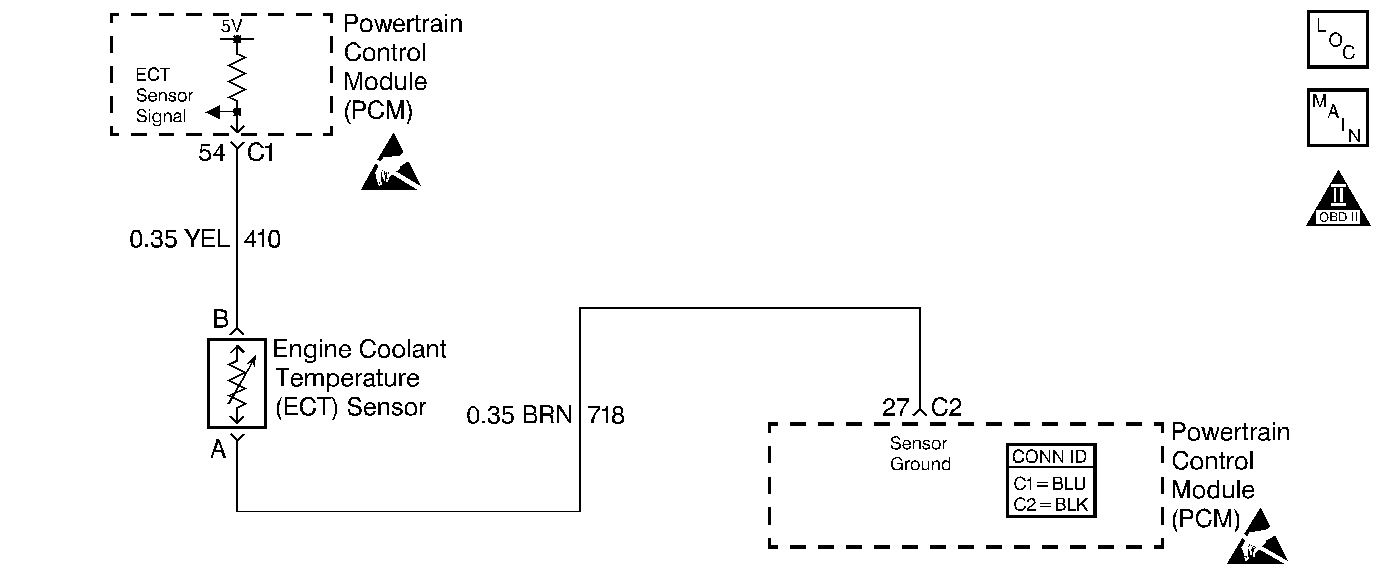
Circuit Description
The purpose of the engine cooling system is to maintain an efficient engine coolant temperature level during all engine operating conditions. This is accomplished by using a thermostat to regulate the flow of engine coolant from the engine to the radiator. The thermostat allows the engine coolant to warm up faster by not allowing the engine coolant to flow through the radiator until the engine coolant has reached the thermostat regulating temperature. An Engine Coolant Temperature (ECT) sensor monitors the temperature of the engine coolant. The Powertrain Control Module (PCM) uses the Engine Coolant Temperature (ECT) sensor input for the following conditions:
| • | Engine control. |
| • | Enabling criteria for some diagnostics. |
The air flow coming into the engine is accumulated and is used to determine if the engine has been driven within the conditions that would allow the engine coolant to heat up to the normal thermostat regulating temperature. The diagnostics that use the engine coolant temperature for enabling criteria may not run when expected if the following conditions exists:
| • | Engine coolant temperature does not increase normally. |
| • | Engine coolant does not reach the thermostat regulating temperature. |
Conditions For Running The DTC
| • | DTCs P0105, P0107, P0108, P0112, P0113, P0117, P0118, P0122, P0123, P0130, P0131, P0132, P0171, P0172, P0201, P0202, P0203, P0204, P0300, P0325, P0336, P0420, P0440, P0442, P0446, P0452, P0453, P0480, P0502, P0503, P0506 or P1441 not set. |
| • | The engine has been running for more than 30 seconds and less than 1200 seconds (20 minutes) |
| • | The minimum Intake Air Temperature (IAT) is more than -7°C (27°F) |
| • | The engine coolant temperature at start up is less than 65°C (149°F) |
Conditions For Setting The DTC
| • | The average air flow is more than 15 g/sec. |
| • | The vehicle has traveled more than 1.5 miles over 25 mph. |
| • | Enough air flow has entered the engine and the engine coolant temperature has not risen to 70°C (158°F) for 30 seconds. |
Action Taken When the DTC Sets
| • | The Malfunction Indicator Lamp (MIL) will illuminate after two consecutive ignition cycles in which the diagnostic runs with the malfunction present. |
| • | The PCM will record the operating conditions at the time that the diagnostic fails. This information will store in the Freeze Frame and Failure Records buffers. |
| • | A history DTC stores. |
| • | The coolant fan turns ON. |
Conditions for Clearing the MIL/DTC
| • | The MIL will turn OFF after three consecutive ignition cycles in which the diagnostic runs without a fault. |
| • | A history DTC will clear after 40 consecutive warm up cycles without a fault. |
| • | Use a scan tool to clear the DTCs. |
Diagnostic Aids
A skewed ECT sensor will cause this DTC code to set.
An intermittent may be caused by the following conditions:
| • | Poor electrical connection |
| • | Rubbed through wire insulation |
| • | Wire broken inside the insulation |
| • | Check for a poor electrical connection or a damaged PCM harness. Inspect the ECT sensor signal circuit and the ground circuit terminals for the following conditions: |
| - | Improper mating |
| - | Broken locks |
| - | Improperly formed connectors |
| - | Damaged terminals |
| - | A poor terminal to wire connection |
| - | Damaged harness |
| • | Perform an intermittent test. If the electrical connections and the harness check OK, monitor a DMM connected between ECT sensor signal circuit and ground circuit terminals while moving the related electrical connectors and the wiring harness. If a malfunction is induced, the resistance reading will change. This may help in order to isolate the location of the malfunction. |
| • | Use the Temperature vs. Resistance table in order to evaluate the possibility of a skewed sensor. Refer to Temperature Versus Resistance . |
Test Description
The numbers below refer to the step numbers on the diagnostic table.
Step | Action | Value(s) | Yes | No |
|---|---|---|---|---|
1 | Did you perform the Powertrain On Board Diagnostic (OBD) System Check? | -- | ||
2 |
Important:: If any other DTCs are set, perform those DTC diagnostics first. With a scan tool, observe if DTC P0128 was set this ignition. Is DTC P0128 set this ignition? | -- | ||
3 |
Does the DTC P0128 reset? | -- | Go to Diagnostic Aids | |
Is the sensor skewed? | -- | Go to Thermostat Diagnosis in Engine Cooling | ||
5 | Replace the ECT sensor. Refer to Engine Coolant Temperature Sensor Replacement . Did you complete the replacement? | -- | -- | |
6 |
Does the DTC reset? | -- | System OK |
